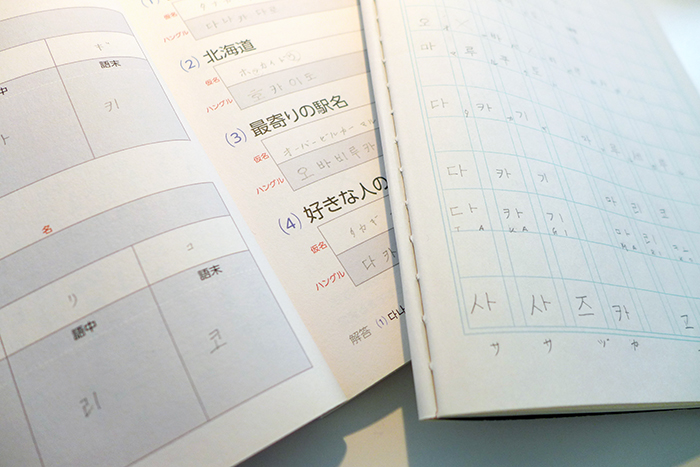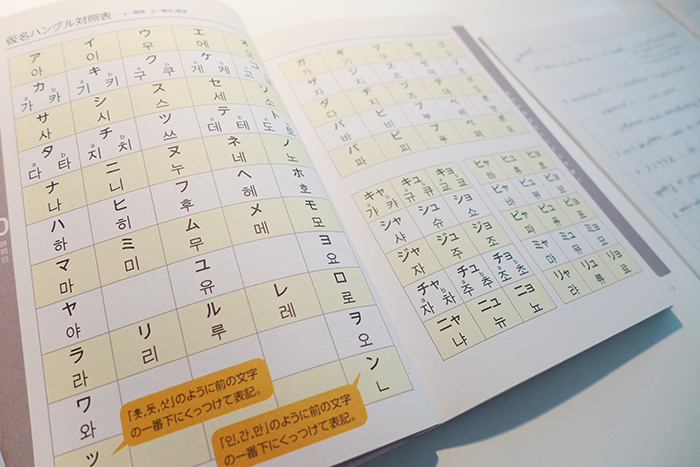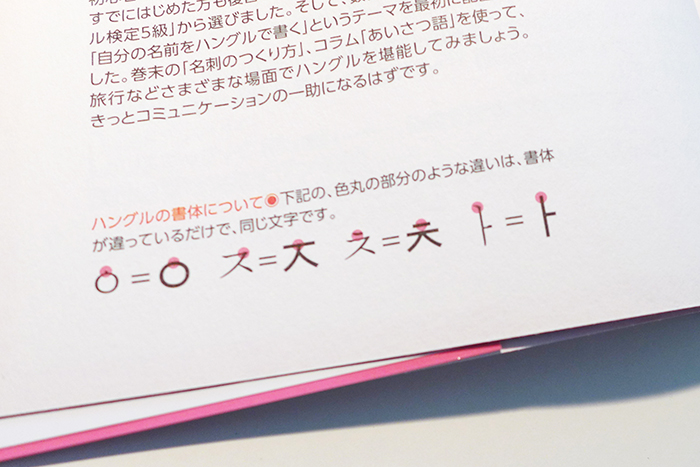#1. 1st day: A Challenge is a Chance – writing Hangul
The writing exercise.
Starting by writing your name might be the very common way to let someone learn a new writing system. Using this Japanese instruction book, written by Hichol Cho, I was glad to have a fully Japanese name. First exercise was to write my name (Takagi Mariko) in katakana: タカギマリコ and using the list in the book I transformed it into Hangul. Great, I can use my knowledge about the Japanese syllabic system to learn Hangul and indeed the single elements of the Hangul characters remind me of Japanese Katakana.
Second step. After using this syllabic idea, the author explains how to divide a Hangul character into consonants and vowels. Hangul seems to bridge or rather unite the idea of alphabetic and syllabic writing systems.
The typeface used for this exercise book is a sans serif and at some parts it was hard for me to guess whether I should write each stroke separately or I should just change the direction of my pencil.
Other questions come up as well:
– How close should I write the single elements within one character?
– Do I need to follow an order to set the strokes?
– The bowl shaped elements are not easy to balance in shape. Especially the flat ones. How can I do it better?
The first chapter was probably not designed for one hour as it took me 25 minutes. I think this was a good choice, as I would like to do more.
Reading of the day.
To get a general idea of the subject, I decided to read two chapters written by the linguist Florian Coulmas for today. This is a summary that focus on the history of the Korean script.
The first writing system introduced and used in Korea was the Chinese Hanzi. Between the 1st and 7th Century, Chinese was the official language for writing in Korea. Gradually Chinese characters were applied to transcribe the Korean language and were called Hanja. Two methods were applied to make it possible to use the Chinese characters for the Korean language: a semantic use and a phonetic. In the semantic way, the Korean word (including its native pronunciation) was assigned to the character of the same meaning in Chinese. For the phonetic method, the Chinese pronunciation was kept while the meaning was cut, and was used to write suffixes and grammatical morphemes. This method of writing Korean with Chinese characters was called Ido. Visually this system must have been confusing as the reader needed to judge wether a character needed to be read phonetically or by its semantic layer. During the 13th Century the phonetically used Chinese characters started to be simplified to enhance their recognisability. {Until this point the development is very similar to the Japanese history of writing, from 4th to 9th Century. Indeed Japanese learned Chinese writing from Korean scholars.}
Two major incidents of the 15th Century influenced the path of writing in Korea. One was the introduction of movable type in the early 15th Century to Korea. Another great invention was made in Korean, the Hangul letters. King Sejong issued in 1446 the royal rescript The correct sounds for instructing people 訓民正音, in which he published the simple phonetic notation system Hangul that he developed together with scholars. This system that was tailor made for the Korean language is the result of a linguistic research and a systematic graphical approach.
“… the invention of what many consider the most scientific and elegant writing system in general use in any country.” (Coulmas 1997, 273)
King Sejong designed this logical writing system to fight illiteracy. However until the 20th Century Hangul was not reputable among the scholarly elite who preferred to use Chinese characters. The turning point for Hangul was 1945, when Korea became independent and Hangul the national script of Korea.
References:
Coulombs, Florian: The Blackweöö Encyclopaedia of Writing Systems. Blackwell, Oxford 1996, 273–277.
Coulombs, Florian: The writing systems of the world. Blackwell, Oxford 1997, 118–122.


